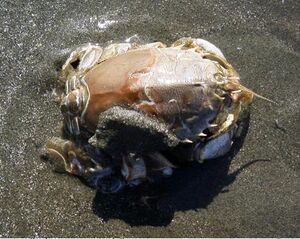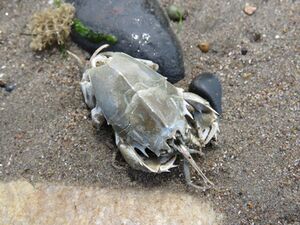كابوريا الرمل
| كابوريا الرمل | |
|---|---|

| |
| Blepharipoda occidentalis | |
| التصنيف العلمي | |
| أصنوفة غير معروفة (أصلحها): | Hippoidea |
| Families | |
كابوريا الرمل هي فصيلة فائقة من قشريات عشاري الأرجل تُعرف باسم سرطان الخلد أو سرطان الرمل.[1][2][3]
علم البيئة
Hippoids are adapted to burrowing into sandy beaches, a habit they share with raninid crabs, and the parallel evolution of the two groups is striking.[4] In the family Hippidae, the body is almost ovoid, the first pereiopods have no claws, and the telson is long, none of which are seen in related groups.[5] Unlike most other decapods, sand crabs cannot walk; instead, they use their legs to dig into the sand.[6] Members of the family Hippidae beat their uropods to swim.[6]
Apart from the polar regions, hippoids can be found on beaches throughout the world. Larvae of one species have also been found in Antarctic waters, despite the lack of suitable sandy beaches in the Antarctic.[7]
تصنيف
Alongside hermit crabs and allies (Paguroidea), squat lobsters and allies (Galatheoidea) and the hairy stone crab (Lomis hirta, Lomisoidea), Hippoidea is one of the four groups that make up the infraorder Anomura.[8] Of the four, Hippoidea is thought to be the most basal, with the other three groups being more closely related to each other than to Hippoidea.[9]
The fossil record of sand crabs is sparse,[10] but extends back to the Cretaceous period.[4] Sand crabs are placed in three families (exclusively fossil taxa are marked †):[11][12]
|
|
المصادر
- ^ Sunil Israel; T. Senthil Murugan; V. P. Venugopalan; T. Subramoniam; N. Munuswamy; G. van der Velde (2006). "Larval development in the sand crab, Emerita emeritus (L., 1767) (Anomura, Hippoidea) reared in the laboratory". Crustaceana. 79 (4): 441–458. doi:10.1163/156854006777554857.
- ^ Sand Fleas (Mole Crabs or Sand Crabs) Prime surf fishing bait
- ^ http://www.baymoon.com/~ilga/crabs/ All About Mole Crabs
- ^ أ ب René H. B. Fraaije. "The first record of albuneid crabs (Crustacea, Decapoda) from the Cretaceous" (PDF). Bulletin of the Mizunami Fossil Museum. 29: 69–72.
- ^ J. Maxwell; D. Cowles; H. Helmstetler (2006). "Key to Infraorder Anomura". Walla Walla University. Archived from the original on September 30, 2008. Retrieved January 4, 2009.
- ^ أ ب Zen Faulkes; Dorothy H. Paul (February 1, 1997). "Digging in sand crabs (Decapoda, Anomura, Hippoidea): interleg coordination". Journal of Experimental Biology. 200 (4): 793–805. doi:10.1242/jeb.200.4.793. PMID 9318562.
- ^ Sven Thatje; Veronica Fuentes (2003). "First record of anomuran and brachyuran larvae (Crustacea: Decapoda) from Antarctic waters" (PDF). Polar Biology. 26 (4): 279–282. Bibcode:2003PoBio..26..279T. doi:10.1007/s00300-002-0476-6. S2CID 19299892.
- ^ Joel W. Martin; George E. Davis (2001). An Updated Classification of the Recent Crustacea (PDF). Natural History Museum of Los Angeles County. p. 132.
- ^ Marcos Pérez-Losada; Carlos G. Jara; Georgina Bond-Buckup; Megan L. Porter; Keith A. Crandall (2002). "Phylogenetic position of the freshwater anomuran family Aeglidae" (PDF). Journal of Crustacean Biology. 22 (3): 670–676. doi:10.1651/0278-0372(2002)022[0670:PPOTFA]2.0.CO;2. S2CID 53621613. Archived from the original (PDF) on 2008-10-31. Retrieved 2007-09-01.
- ^ Christopher B. Boyko (2004). "A new genus of fossil sand crab (Anomura: Albuneidae) from the Oligocene of Italy". Palaeontology. 47 (4): 933–936. Bibcode:2004Palgy..47..933B. doi:10.1111/j.0031-0239.2004.00391.x.
- ^ Christopher B. Boyko (2002). "A worldwide revision of the Recent and fossil sand crabs of the Albuneidae Stimpson and Blepharipodidae, new family (Crustacea, Decapoda, Anomura, Hippoidea)" (PDF). Bulletin of the American Museum of Natural History. 272: 1–396. doi:10.1206/0003-0090(2002)272<0001:AWROTR>2.0.CO;2. Archived from the original (PDF) on 2007-07-05. Retrieved 2007-09-01.
- ^ Sammy De Grave; N. Dean Pentcheff; Shane T. Ahyong; et al. (2009). "A classification of living and fossil genera of decapod crustaceans" (PDF). Raffles Bulletin of Zoology. Suppl. 21: 1–109. Archived from the original (PDF) on 2011-06-06.
وصلات خارجية
 Information related to كابوريا الرمل from Wikispecies.
Information related to كابوريا الرمل from Wikispecies.

